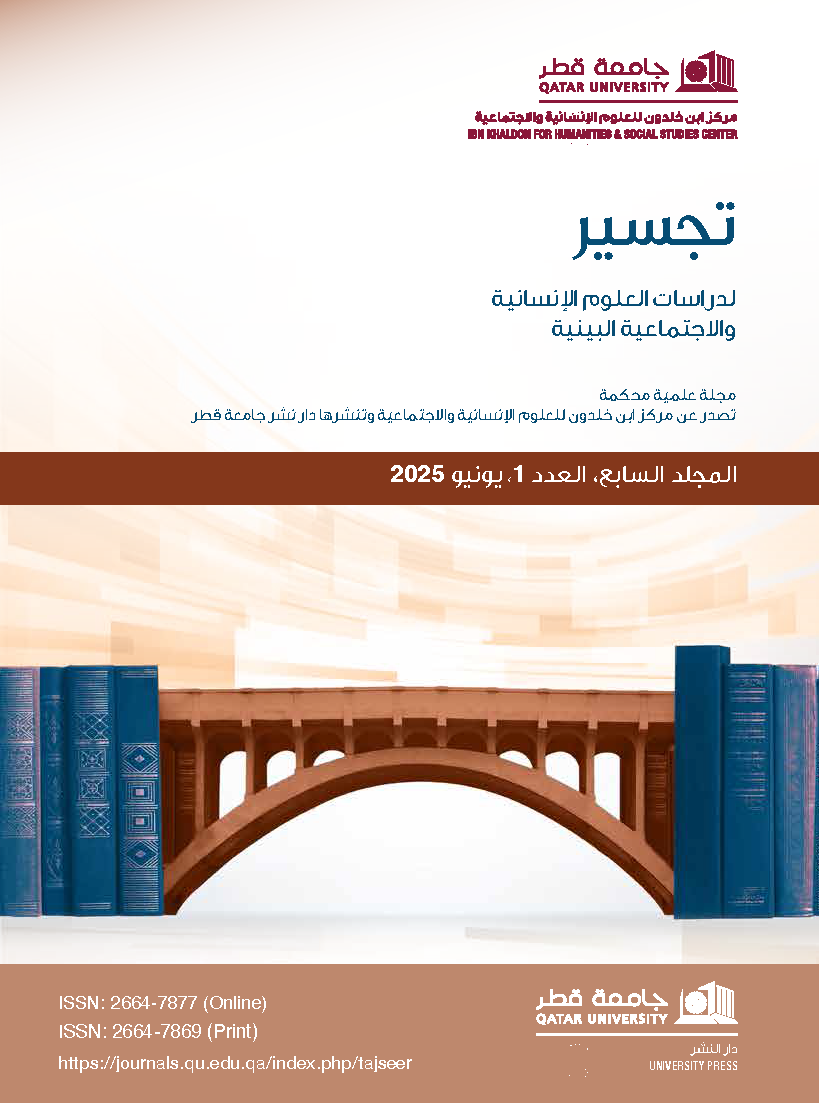النماذج الاقتصاديّة والدّين الإسلامي: تقييم نقدي للمقاربات الاختزاليّة
الملخص
يقدّم هذا البحث تحليلًا نقديًّا لتطبيق النماذج الاقتصاديّة على المبادئ والشعائر الإسلاميّة. فعلى الرغم من أن اقتصاديّات الدّين قد أصبحت مجالًا متناميًا للدراسة، تُبرز هذه الدراسة أن توظيفه في دراسة الدين الإسلامي يؤدي في كثير من الأحيان إلى مقاربات اختزاليّة تُفرغ الدين من جوهره، عبر اختزال التجارب الروحيّة المعقدّة إلى مجرد دوافع ماديّة. ومن خلال دراسة حالات تفصيليّة للإسهامات البحثيّة البارزة في هذا الحقل المعرفي، يكشف البحث محدوديّة النماذج الاقتصاديّة التحليليّة في فهم الممارسات الإسلاميّة، نتيجة إغفالها للأسس العقدية، وفرضها تفسيرات ماديّة، وتبنّي افتراضات لا تاريخيّة، فضلًا عن تجاهلها أبعاد المصلحة المتجذّرة في علم مقاصد الشريعة. تخلص الورقة البحثيّة إلى أن المقاربات الاقتصادية الراهنة للمبادئ الإسلاميّة تقصر عن تقديم فهم متكامل للمعتقد والممارسة الدينيّة. وبناءً على ما تقدّم، يسهم هذا النقد في إثراء النقاش الأكاديمي حول حدود المنهجيّة الاقتصاديّة في دراسة الأبعاد الدينيّة والروحيّة للتجربة الإنسانيّة.
المقاييس
##plugins.themes.bootstrap3.article.details##
اقتصاديّات الدّينالإسلامالاختيار العقلانيالاختزاليّةالمقاصد
Al-Ghazālī, Abū Ḥāmid Muḥammad. al-Muṣṭafá min ʻilm al-uṣūl (in Arabic). Beirut: Dar al-Kutub al-'Ilmiyya, 1997.
Al-Raysuni, Ahmad. Imam Al-Shatibi's Theory of the Higher Objectives and Intents of Islamic Law. London: International Institute of Islamic Thought, 2005.
Al-Sakrān, Ibrāhīm. maʼālāt al-khiṭāb al-madanī (in Arabic). al-Riyāḍ: Dār al-Waʻy lil-Nashr wa-al-Tawzīʻ, 1435AH - 2013.
Al-Shāṭibī, Ibrāhīm ibn Mūsá. al-Muwāfaqāt fī uṣūl al-sharīʻah (in Arabic). Al-Khobar: Dar Ibn Affan, 1997.
Alwin, Duane F., Jacob L. Felson, Edward T. Walker and Paula A. Tufiş. “Measuring Religious Identities in Surveys,” International Journal of Public Opinion Quarterly, Vol. 70, No. 4 (2006), pp. 530-564. https://doi.org/10.1093/poq/nfl024
Auda, Jasser, Maqasid Al-Shari’ah as Philosophy of Islamic Law: A Systems Approach. London: International Institute of Islamic Thought, 2008.
Azzi, Corry and Ehrenberg, Ronald. “Household Allocation of Time and Church Attendance,” Journal of Political Economy, Vol. 83, No. 1 (1975), pp. 27-56. https://doi.org/10.1086/260305
Barro, Robert J. and McCleary, Rachel M. “Religion and Economic Growth Across Countries,” American Sociological Review, Vol. 68, No. 5 (2003), pp. 760-781. https://doi.org/10.1177/000312240306800505
Berman, Eli and Laitin, David D. “Religion, Terrorism and Public Goods: Testing the Club Model,” Journal of Public Economics, Vol. 92, No. 10-11 (2008), pp. 1942-1967.
Bruce, Steve. “Religion and Rational Choice: A Critique of Economic Explanations of Religious Behavior,” Sociology of Religion, Vol. 54, No. 2 (1993), pp. 193-205. https://doi.org/10.2307/3712139
Carvalho, Jean-Paul. “Religious Clubs: The Strategic Role of Religious Identity,” In: Jean-Paul Carvalho & Sriya Iyer & Jared Rubin (eds.), Advances in the Economics of Religion, edited by (Cham: Palgrave Macmillan, 2019), pp.25-41.
–––. “Sacrifice and Sorting in Clubs,” In Forum for Social Economics. Routledge, 2020.
–––. “Veiling,” The Quarterly Journal of Economics, Vol. 128, No. 1 (2013), pp. 337-370. https://doi.org/10.1093/qje/qjs045
Chapra, M. Umer. The Future of Economics: An Islamic Perspective, Vol. 21. (Leicestershire: Kube Publishing Ltd., 2016).
–––. The Islamic Vision of Development in the Light of Maqasid Al-Shariah. London: International Institute of Islamic Thought, 2008.
Copson, Andrew. “What is Humanism?” in: Andrew Copson, A. C. Grayling (eds.), The Wiley Blackwell Handbook of Humanism (New Jersey: John Wiley & Sons, 2015), p. 1-33.
Dusuki, Asyraf Wajdi and Bouheraoua, Said. “The Framework of Maqasid al-Shariah and its Implication for Islamic Finance,” Islam and Civilisational Renewal, Vol. 2, No. 2 (2011), p. 316-336.
Ehrenberg, Ronald G. “Household Allocation of Time and Religiosity: Replication and Extension,” Journal of Political Economy, Vol. 85, No. 2 (1977), pp. 415-423. DOI: 10.1086/260573
Ertman, Martha and Williams, Joan C. Rethinking Commodification: Cases and Readings in Law and Culture. New York: NYU Press, 2005.
Fine, Ben and Milonakis, Dimitris. From Economics Imperialism to Freakonomics: The Shifting Boundaries Between Economics and Other Social Sciences (London: Routledge, 2009).
Finke, Roger and Iannaccone, Laurence R. “Supply-Side Explanations for Religious Change.” The Annals of the American Academy of Political and Social Science, Vol. 527, No. 1 (1993), pp. 27-39. https://doi.org/10.1177/0002716293527001003
Gharāyibah, Ibrāhīm. al-Islām wālʼnsnh. Maʻārik min ajl al-ansanah fī al-siyāq al-Islāmī (in Arabic). Al Jazeera, Date of Access 27 October 2024, https://tinyurl.com/mwuwasv3
Gilboa, Itzhak., Minardi, Stefania and Wang, Fan. “Schumpeter Lecture 2023: Rationality and Zero Risk.” Journal of the European Economic Association, Vol. 22, No. 1 (2024), pp. 1-33. https://doi.org/10.1093/jeea/jvad071
Grudin, Robert. “Humanism,” Encyclopedia Britannica, Date of Access: 1 February 2025, https://www.britannica.com/topic/humanism.
Hallaq, Wael B. An Introduction to Islamic Law. Cambridge University Press, 2009.
Haneef, Mohamed Aslam and Furqani, Hafas. “Methodology of Islamic Economics: Overview of Present State and Future Direction,” International Journal of Economics, Management and Accounting, Vol. 19, No. 1 (2011). https://doi.org/10.31436/ijema.v19i1.175
Laurence R., Iannaccone. “A Formal Model of Church and Sect,” American Journal of Sociology, Vol. 94 (1988), pp. S241-S268.
–––. “Introduction to the Economics of Religion,” Journal of Economic Literature, Vol. 36, No. 3 (1998), pp. 1465-1495.
–––. “Rational Choice: Framework for the Scientific Study of Religion 1,” Rational Choice Theory and Religion (2016), pp. 25-45.
–––. “Risk, Rationality, and Religious Portfolios,” Economic Inquiry, Vol. 33, No. 2 (1995b) pp. 285-295. https://doi.org/10.1111/j.1465-7295.1995.tb01863.x
–––. “Voodoo Economics? Reviewing the Rational Choice Approach to Religion,” Journal for the Scientific Study of Religion (1995a), pp. 76-88.
Iannaccone, Laurence R. and Berman, Eli. “Religious Extremism: The Good, the Bad, and the Deadly,” Public Choice, Vol. 128 (2006), pp. 109-129. https://doi.org/10.1007/s11127-006-9047-7
Islamic Corporation for the Development of the Private Sector (ICD), “Refinitiv Islamic Finance Development Report 2022 Embracing Change” Date of Access: 1 February 2025, https://icd-ps.org/uploads/files/ICD%20Refinitiv%20ifdi-report-20221669878247_1582.pdf
Iyer, Sriya. “The New Economics of Religion,” Journal of Economic Literature, Vol. 54, No. 2 (2016), pp. 395-441. https://doi.org/10.1257/jel.54.2.395
Kahf, Monzer. “Islamic Economics: Notes on Definition and Methodology,” Review of Islamic Economics (2003), pp. 23-48.
Kamali, Mohammad Hashim. Maqasid al-Shari'ah Made Simple. London: International Institute of Islamic Thought, 2008.
Khan, M. Fahim. “An Alternative Approach to Analysis of Consumer Behaviour: Need for Islamic Theory,” Turkish Journal of Islamic Economics, Vol. 1, No. 1 (2013), pp. 17-42.
Kumar, Vikas. “A Critical Review of Economic Analyses of Religion,” IGIDR WPS 23 (2008).
Lawson, Tony. Economics and Reality. London: Routledge, 1997.
McAndrew, Siobhan and Voas, David. “Measuring Religiosity Using Surveys,” Survey Question Bank: Topic Overview 4. (Survey Resources Network Question Bank) University of Surrey, 2011.
Michalopoulos, Stelios., Naghavi, Alireza and Prarolo, Giovanni. “Islam, Inequality and Pre-Industrial Comparative Development,” Journal of Development Economics, Vol. 120 (2016), pp. 86-98. https://doi.org/10.1016/j.jdeveco.2016.01.002
Montgomery, James D. “A Formalization and Test of the Religious Economies Model,” American Sociological Review, Vol. 68, no.5 (2003), pp. 782-809.
–––. “Contemplations on the Economic Approach to Religious Behavior,” The American Economic Review, Vol. 86, No. 2 (1996), pp. 443-447.
Nasr, Seyyed Hossein, Traditional Islam in the Modern World. London: Kegan Paul International, 1987.
Palmer, Daniel E. “Economic Rationality,” Encyclopedia Britannica, Date of Access: 1 February 2025, https://www.britannica.com/money/economic-rationality.
Said, Edward W. Orientalism. New York, Pantheon Books, 1978.
Saleh, Mohamed and Tirole, Jean. Taxing Identity: Theory and Evidence from Early Islam, Econometrica, Vol. 89, No. 4 (2021), pp. 1881-1919. https://doi.org/10.3982/ECTA17265
Siddiqi, M. Nejatullah. Riba, Bank Interest and the Rationale of its Prohibition. Jeddah: Islamic Research and Training Institute, Islamic Development Bank, 2004.
Smith, Jane Idelman and Yazbeck Haddad, Yvonne. The Islamic Understanding of Death and Resurrection. Oxford: Oxford University Press, 2002.
Tarakeshwar, Nalini., Stanton, Jeffrey and Pargament, Kenneth I. “Religion: An Overlooked Dimension in Cross-Cultural Psychology,” Journal of Cross-Cultural Psychology, Vol. 34, No. 4 (2003), pp. 377-394. https://doi.org/10.1177/0022022103034004001
Taylor, Charles. A Secular Age. Cambridge, MA: Belknap Press of Harvard University Press, 2007.
Woodhead, Linda. “Five Concepts of Religion,” International Review of Sociology, Vol. 21, No. 1 (2011), pp. 121-143. https://doi.org/10.1080/03906701.2011.544192
Zaman, Asad. “An Islamic Critique of Neoclassical Economics,” Pakistan Business Review, Vol. 14, No. 1 (2012), pp. 9-62.
***************************************************************************
I. Arabic:
الغزالي، أبو حامد محمد. المصطفى من علم الأصول. بيروت: دار الكتب العلمية، 1997.
السكران، إبراهيم. مآلات الخطاب المدني. الرياض: دار الوعي للنشر والتوزيع، 2013.
الشاطبي، إبراهيم بن موسى. الموافقات في أصول الشريعة. الخبر: دار ابن عفان، 1997.
غرايبة، إبراهيم. "الإسلام والأنسنة.. معارك من أجل الأنسنة في السياق الإسلامي". الجزيرة. 3 أكتوبر 2004. استرجع في 28/10/2024، من الرابط: https://tinyurl.com/mwuwasv3.



 https://orcid.org/0000-0003-2383-0093
https://orcid.org/0000-0003-2383-0093